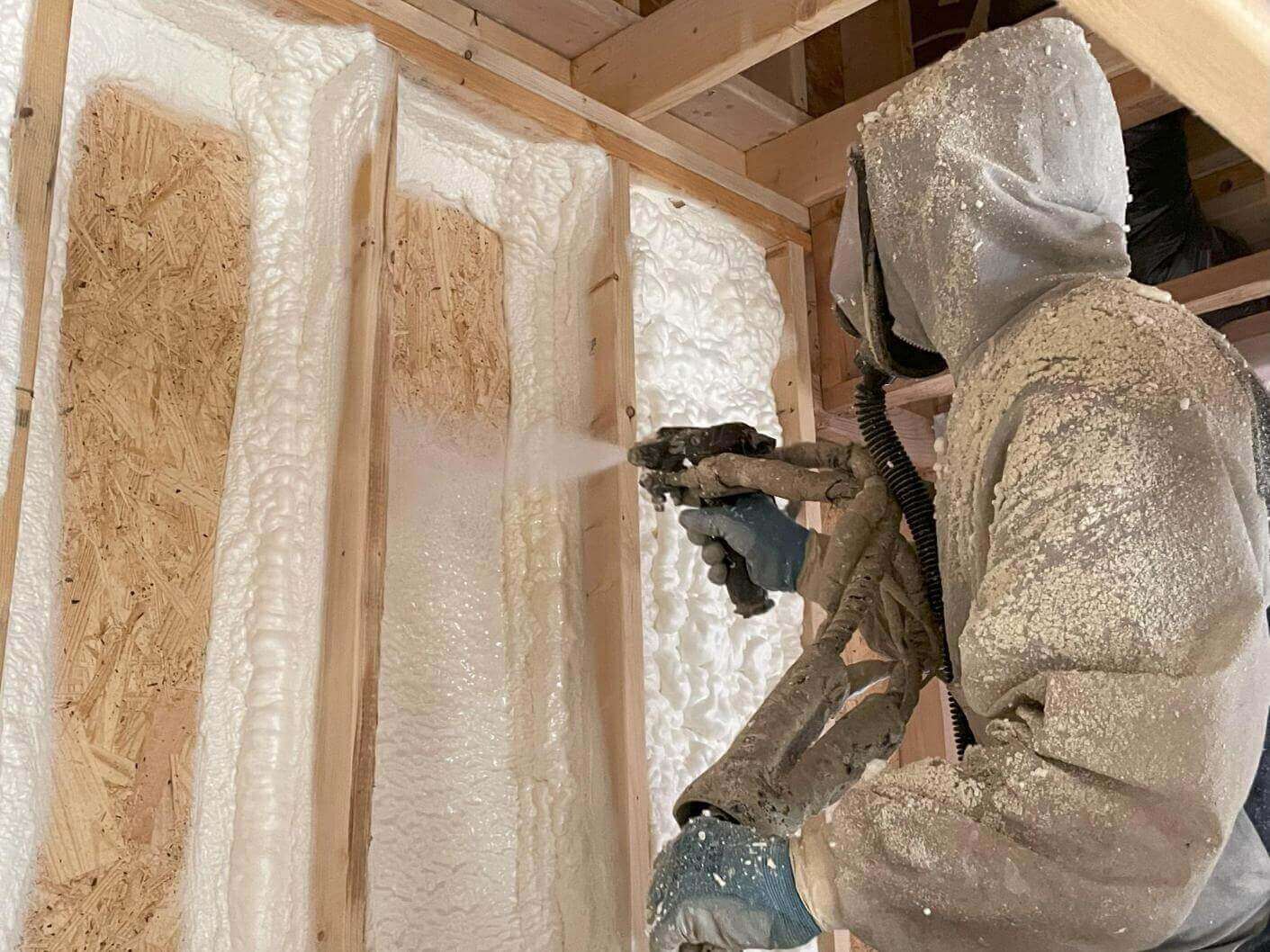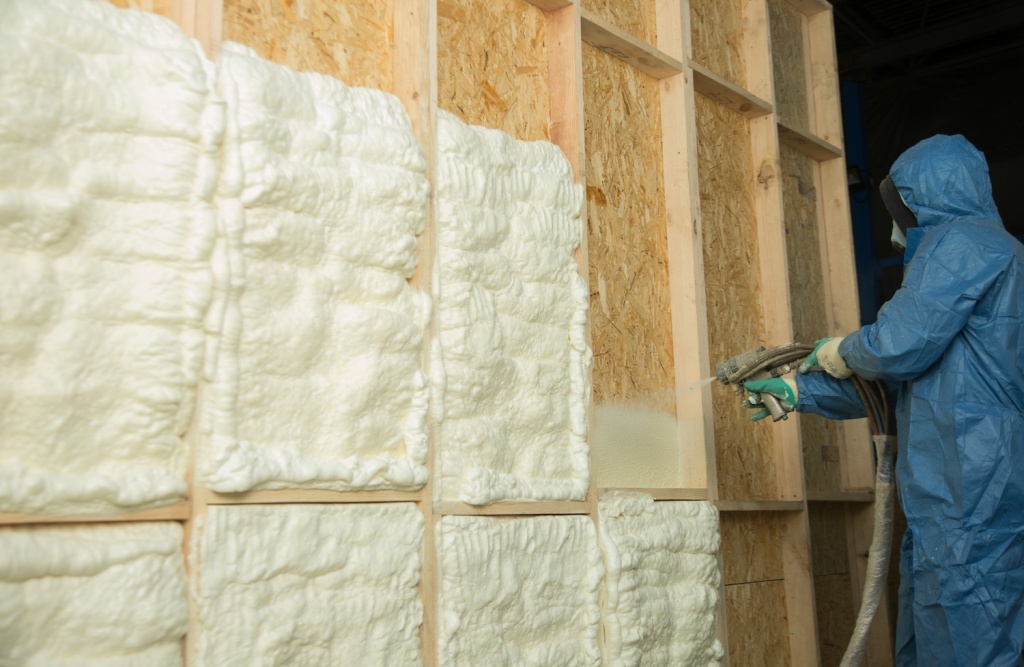Exactly How Spray Foam Can Boost Power Effectiveness in Any Type Of Structure
Spray foam insulation has actually arised as a pivotal solution for improving energy effectiveness throughout numerous structure types. By creating a closed seal that reduces air leakage, it successfully manages indoor environments while dramatically decreasing home heating and cooling prices. Its excellent R-value and moisture-resistant buildings contribute to long-term energy savings and boosted structure long life. As homeowner increasingly seek lasting solutions, the implications of spray foam insulation expand beyond mere energy financial savings. The full scope of its advantages, nevertheless, warrants a closer assessment of how it can change power monitoring methods in both residential and industrial setups.
Comprehending Spray Foam Insulation
Spray foam insulation is progressively identified for its remarkable thermal efficiency and adaptability in various applications. Composed largely of polyurethane, this insulation material is applied as a liquid that broadens upon get in touch with, filling up voids and creating a seamless obstacle. This special property enables spray foam to satisfy uneven surface areas, making it a perfect selection for both residential and business frameworks.

Application of spray foam insulation is normally done by qualified specialists making use of specific tools, making certain optimal performance and safety - Spray Foam. The treating process is quick, permitting quick installation and marginal interruption. Consequently, spray foam insulation is increasingly being used in new building and retrofitting jobs due to its ability to improve architectural integrity while improving overall power effectiveness in structures
Benefits of Energy Efficiency
Power efficiency plays a pivotal duty in lowering operational costs and decreasing environmental effect throughout various markets. By enhancing power use, organizations and property owners can attain substantial savings on energy bills, which straight boosts monetary efficiency. Reliable power usage means less reliance on fossil gas, consequently adding to a reduction in greenhouse gas exhausts and advertising a more sustainable environment.
In addition, energy-efficient structures typically experience boosted residential property worths. As energy prices increase and sustainability becomes a concern for consumers, properties with boosted energy effectiveness features are extra eye-catching on the marketplace. This trend motivates financial investment in energy-saving modern technologies, which can better drive development and economic development.
Along with environmental and economic benefits, power performance can also enhance the overall comfort and wellness of indoor rooms. Appropriate insulation and reliable cooling and heating systems assist maintain regular temperature levels, minimizing drafts and moisture degrees, which in turn can cause better interior air high quality.
Ultimately, the benefits of power efficiency prolong beyond immediate savings, promoting a resistant economy, advertising environmental stewardship, and enhancing the high quality of life for owners in any kind of building.
Exactly How Spray Foam Works
Typically used as a liquid, spray foam increases quickly upon call with surfaces, developing a solid barrier that properly secures spaces and splits. This distinct home results from its chemical composition, largely being composed of polyols and isocyanates, which react when blended to develop a foam that fills up voids and adheres to different products, including wood, steel, and concrete.
When used, the foam expands to numerous times its initial volume, making certain a tight seal that stops air leak. This process dramatically reduces thermal bridging, which takes place when warm transfers with materials, bring about energy loss. The foam's high R-value, a step of thermal resistance, contributes to improved insulation by lessening heat transfer between the exterior and interior environments.
Additionally, spray foam is resistant to moisture and bugs, further improving its efficacy in maintaining energy efficiency. Its application can be tailored to different areas, including attics, wall surfaces, and crawl areas, enhancing insulation throughout a building. Spray Foam. On the visit here whole, the cutting-edge layout and application method of spray foam make it a reliable option for enhancing power efficiency in any framework, leading to minimized power expenses and a much more sustainable built environment

Applications in Various Buildings
Various applications of spray foam insulation can be located throughout different structure kinds, enhancing power performance and convenience. In household homes, spray foam is often utilized in walls and attic rooms to create a seamless obstacle versus air leaks, considerably decreasing home heating and cooling down needs. This application is especially valuable in older homes, where traditional insulation might be insufficient.
In commercial buildings, spray foam insulation is put on roof systems and outside walls, which aids to improve thermal performance and shield against moisture intrusion. Its light-weight nature makes it an excellent selection for retrofitting existing structures without adding considerable weight. Furthermore, spray foam can be made use of in commercial setups to insulate pipelines and tank, maintaining temperature control for sensitive products.
Institutional structures, check that such as colleges and hospitals, take advantage of spray foam insulation by making certain a constant indoor climate that supports passenger comfort and health. The versatility of spray foam allows it to adjust to different building sizes and shapes, making it a favored option for designers and home builders looking for efficient insulation options. On the whole, spray foam insulation offers as a critical element in achieving energy-efficient buildings throughout all industries.
Long-Term Expense Cost Savings
Spray foam insulation uses considerable look at this now long-lasting cost savings for structure proprietors and owners by reducing power intake and reducing energy expenses. By offering a superior air seal, spray foam decreases the seepage of outdoors air, thus enhancing the thermal efficiency of a building. This leads to a lot more efficient home heating and cooling processes, which can cause substantial decreases in energy expenses over time.
Along with instant financial savings on utility costs, the longevity and long life of spray foam insulation add to its monetary advantages. Unlike conventional insulation products, which may sag, clear up, or deteriorate, spray foam maintains its performance for years, reducing the requirement for constant replacements or repair services. This longevity converts to decrease upkeep costs and much less disruption for occupants.
Furthermore, structures outfitted with spray foam insulation typically appreciate an increase in residential or commercial property value, making them much more enticing to possible buyers or occupants. As power efficiency ends up being progressively prioritized, properties with effective insulation options stand out in the market. Inevitably, the combination of spray foam insulation not just boosts comfort however likewise represents a critical investment that produces significant monetary advantages over the long term.
Verdict
To conclude, spray foam insulation functions as an essential component in boosting power performance throughout diverse structure types. Its capacity to produce a smooth barrier against air leakage, combined with moisture-resistant residential properties and high r-values, significantly reduces power intake and linked prices. The execution of spray foam not just contributes to constant interior temperatures but likewise increases home value, highlighting its duty as a prudent investment for both domestic and industrial homes.
Spray foam insulation has actually arised as a critical remedy for boosting power effectiveness across different structure types. Spray Foam. As an outcome, spray foam insulation is increasingly being employed in brand-new building and retrofitting jobs due to its ability to improve structural stability while enhancing overall power effectiveness in buildings
Overall, the cutting-edge layout and application technique of spray foam make it an efficient remedy for enhancing energy effectiveness in any type of structure, leading to minimized power prices and a more lasting constructed environment.
Various applications of spray foam insulation can be located throughout numerous structure types, improving energy performance and comfort.In conclusion, spray foam insulation serves as an important element in improving power efficiency across diverse structure types.
Comments on “Contrasting Spray Foam to Conventional Insulation: Which Is Much better?”